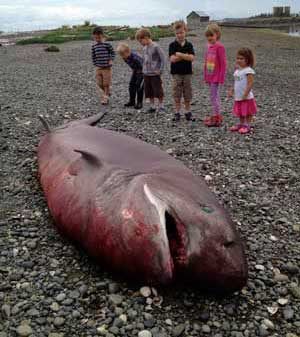Teachable moments come along all the time for scientists conducting summer classes at University of Washington’s Friday Harbor Labs.
But few like this.
The Labs biological preserve at San Juan Island’s Argyle Lagoon became a makeshift laboratory Wednesday afternoon, June 26, after a call came in that a 12-foot-long sixgill shark had washed up on the beach.
Students and instructors bundled up a batch of scientific equipment and exited the marine facility en masse, according to biologist Adam Summers, a shark specialist and associate director of the Labs comparative biomechanics department.
“This was beyond a rare opportunity,” he said. “It’s just a very big animal to have washed up on the beach in this area, and one that had just died.”
Jenny Atkinson can’t recall a single sixgill stranding incident in the San Juans during her tenure as director of the Friday Harbor Whale Museum, which operates the local Marine Mammal Stranding Network.
Sixgills, also known as cow sharks, are deep-water creatures, at home in the outer ocean at depths as great as 3,000 feet. The name reflects its distinctive feature, as all other sharks have five gills. 
Slow-moving yet deadly, they prey on large fish and other sharks by methodically sidling up next to an intended target and then attacking with an enormous burst of speed.
Lopez Island’s Gene Helfman, professor emeritus at the University of Georgia’s Odum School of Ecology, said that because sixgills live at such great depths not a lot is known about their behaviors. However, he said the prevailing theory is that females venture into shallow and protected inland waters of Puget Sound to give birth.
Helfman noted that a 14-foot-long female sixgill was carrying 80 embryos, or “pups”, as they’re called, when it washed up on a beach near Shelton in 2007. It died shortly after it stranded.
Females can store sperm from multiple males and then give birth to a litter of pups that have a different genetic makeup from their siblings, he noted.
Back at Argyle Lagoon, Summers said that the call the Labs received suggested the massive female might still be alive and that it may be carrying “pups”. Its body appeared to be completely intact.
Although neither suggestion turned out to be true, he said that post-mortem twitching of nerves was the most likely cause for the movement of the shark that some early arrivals had noticed before the team of scientists and students arrived at the beach.
Given the size of the shark, Summers estimates its age at anywhere between 25-50 years. The shark was examined, dissected and various parts were carted back to the Labs for further study, but the cause of its death remains undetermined, Summers said.
“There’s no sign of trauma or of area of a big parasitic condition,” he said. “It might just be a case of old age.”
— Editor’s note: The photo embedded in this article was contributed by Terence Finan.



